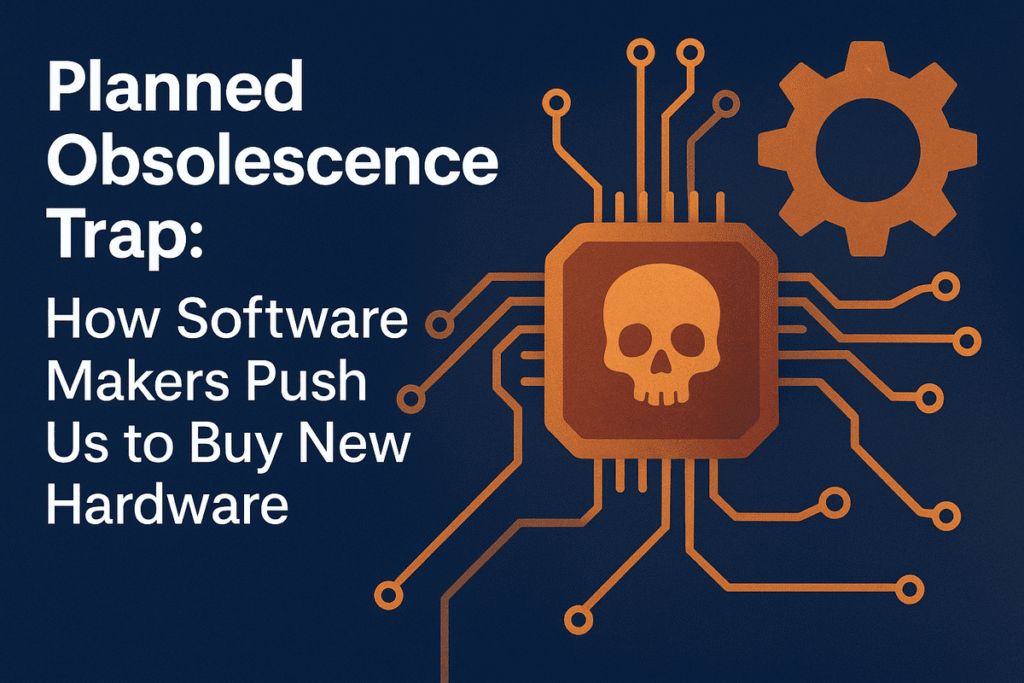
Planned Obsolescence Trap: How Software Makers Push Us to Buy New Hardware
⚙️ The Silent Cycle of Digital Expiration
In the digital age, progress is marketed as innovation. But behind every new operating system, software update, or hardware release lies a silent and relentless cycle — one designed not just to improve performance, but to force obsolescence. This is the planned obsolescence trap, a carefully engineered relationship between software makers and hardware manufacturers that ensures your perfectly functional computer eventually becomes “too old to run the latest version.”
Your device doesn’t fail because it’s broken. It fails because someone decided it should.
Starting at age 44, your energy, metabolism, and overall well-being may be silently declining. Don’t wait for symptoms.
💻 When Software Dictates Hardware’s Fate
Every year, millions of computers are declared obsolete — not because their components have stopped working, but because new software suddenly “requires” capabilities their hardware supposedly lacks.
Operating systems like Windows 11 have set hardware barriers that exclude older yet fully operational processors. Security, efficiency, and compatibility are the reasons we’re told. But in many cases, these updates are simply a clever way to restart the buying cycle.
Meanwhile, tech giants benefit twice: hardware companies like Intel, AMD, HP, or Dell sell new devices, while software developers such as Microsoft profit from licensing and cloud subscriptions tied to these updates.
🔁 The Apple vs. Microsoft Rivalry: Innovation or Manipulation?
Apple and Microsoft have long stood as the two titans of modern computing — one controlling both hardware and software, the other dominating the software world.
Apple’s transition from Intel processors to its own M-series chips was a bold move toward independence, but it also marked a new layer of obsolescence. Millions of Mac users suddenly found their older machines incompatible with new macOS features and applications.
Microsoft, on the other hand, relies on a vast network of hardware partners. Its approach to planned obsolescence is subtler — hidden behind minimum requirements and end-of-support deadlines. Windows 10, for instance, will soon lose official support, leaving countless users with two options: upgrade hardware or risk security vulnerabilities.
In this rivalry, innovation is real — but so is the manipulation. Progress is often packaged as necessity.
⚡ The Business of Expiration
Planned obsolescence is not just a technical strategy; it’s a psychological one.
Consumers are conditioned to equate “new” with “better.” Marketing campaigns glorify speed, design, and innovation — even when the performance gap between generations is marginal.
The result? Perfectly working machines end up in landfills, while global e-waste continues to surge.
Behind this cycle lies a simple truth: as long as devices keep failing by design, the industry keeps winning.
🌍 The Real Cost — and the Future We Can Choose
The greatest victims of planned obsolescence aren’t just our wallets, but the planet itself.
Every forced upgrade contributes to environmental degradation through resource extraction, manufacturing emissions, and electronic waste.
But there’s hope.
The rise of open-source systems like Linux, modular hardware initiatives, and repair-friendly movements (such as Right to Repair) signal a growing resistance. The future doesn’t have to be disposable. It can be sustainable, upgradable, and fair — if we demand it.
💬 Final Reflection
We are not merely consumers of technology. We are participants in an ecosystem driven by design and demand.
Recognizing the trap is the first step to escaping it. The next step is to choose wisely — to extend the life of what we own, support transparent innovation, and remind the tech giants that progress should empower, not enslave.
Discover More of Technology Splendor: Explore Our Other Sites
Your Health is your Best Investment
Energy, clarity, and balance are the foundation of every dream. Without health, wealth loses its shine and relationships lose their spark. Discover strategies to strengthen your body, sharpen your mind, and energize your spirit.
Learn How to Protect It →Relationships Give Life Meaning
Health gives you energy. Wealth gives you freedom. But only deep, authentic relationships give life true purpose. Discover the tools to connect, love, and communicate at your best.
Improve your Personal and Business Relationships
